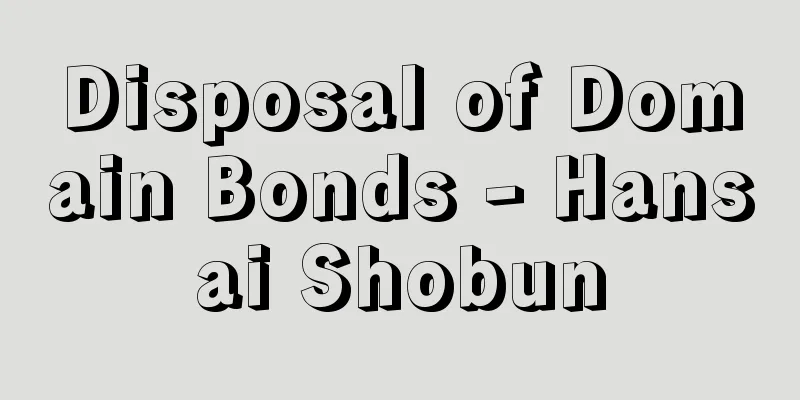Zion

|
When neighboring countries of China, which did not have their own characters, imported Chinese characters as writing tools, they also adopted the Chinese pronunciations that accompanied each character and established them in their own languages. It is also called "Chinese character sounds" or simply "sounds." The original Chinese pronunciation is called "Chinese (Han) sounds," while a distinction is made between "Japanese (Han) sounds," "Korean (Han) sounds," "Vietnamese (Han) sounds," and so on. Chinese sounds themselves fluctuate depending on the era and dialect, and the sounds of each country also differ depending on the era and dialect in which they were adopted, and the phonological systems of each country are also different, so each has undergone its own unique changes. [Katsuaki Numamoto] Chinese pronunciationIn Chinese, each character has one syllable, and each syllable is divided into an initial consonant and a rhyme. The rhyme is further divided into three elements: a medial consonant, a vowel, and an ending. The tone of each character is added to this, and the syllable structure can be abstracted as IMVE/T. Taking the Sui and Tang dynasties, which are most closely related to Japanese character sounds, as an example, the initial consonant T is broadly divided into seven types depending on the place of articulation: labial (series), lingual (t series), fang (k series), dental (s/ts series), guttural (h series), semi-lingual (l), and semi-dental (ɲ), each of which is further divided by aspirated/unaspirated and voiced/voiceless, for a total of 41 types, and the standard number of rhymes IMV, including tone distinctions, is 206. In addition, the tones are divided into four types: flat tones (hyosheng), high tones (josheng), absent tones (kyosheng), and entering tones (nissheng), which are called the four tones. [Katsuaki Numamoto] Japanese pronunciationJapanese pronunciation can be roughly divided into four systems according to the time of introduction and the Chinese dialect on which it was based: Sangō-on, Go-on (also called Wa-on or Tsushima-on), Kan-on (also called Shō-on or Tō-on), and Sō-on (also called Tō-on). Sangō-on are the pronunciations that are the basis of Man'yōgana characters such as "ga," "ga," "so," "yo," and "ro," and were created before the introduction of Go-on, and are small in number. Go-on includes characters such as "ku," "ge," "kon," "se," and "miyau," and is presumed to have been introduced from the Chinese pronunciation of the southern Wu region in the 5th to 6th centuries, either directly or via Korea, mainly as the pronunciation for reciting Buddhist scriptures. Kan'on includes "Kiu," "Yi," "Kin," "Shi," and "Mei," and is thought to have been the standard pronunciation of Luoyang and Chang'an during the Tang Dynasty, which was directly adopted by monks who went to Tang China or naturalized people. In the early Heian period, it was called "Seion," and there is evidence that Chinese pronunciation was faithfully studied with the encouragement of the imperial court. The above-mentioned Go'on and Kan'on are the two major systems that form the basis of Japanese pronunciation, as Chinese pronunciation was imported as a whole system and established as Japanese pronunciation. Song'on was introduced after the end of the Heian period, and there is a distinction between two layers: the southern Chinese pronunciation of the Song and Yuan dynasties, which was adopted mainly by Zen monks, and the southern Chinese pronunciation of the Ming and Qing dynasties, which was adopted by Zen monks and through trade, but the boundary between them is not necessarily clear. In terms of their influence and degree of adoption in the Japanese language, this type of consonant pronunciation has only supported certain vocabulary (goi) such as 'andon' (lantern), 'isu' (chair), 'chyouchin' (paper lantern), 'uron' (confused language), 'oshiyau' (priest), and 'fushin' (construction), in addition to sutra chanting (fugin) in Zen Buddhism. [Katsuaki Numamoto] "A Study of the Three Sounds of Kanji" (included in the Complete Works of Motoori Norinaga 5, 1970, Chikuma Shobo)" ▽ "A Study of Chinese Words in the Japanese Language, by Yamada Takao (1970, Hobunkan Publishing) " ▽ "A Study of the Sounds of Vietnamese Chinese Characters, by Mineya Toru (Heibonsha, Toyo Bunko)" ▽ "The Collected Works of Kono Rokuro 2: A Study of the Sounds of Korean Chinese Characters (1979, Heibonsha) " ▽ "Chinese Phonology, by Todo Akiyasu (1957, Konan Shoin)" ▽ "A Study of the Sounds of Japanese Chinese Characters in the Heian and Kamakura Periods, by Numamoto Katsuaki (1982, Musashino Shoin)" ▽ "A Study of the Sounds of Japanese Chinese Characters, by Takamatsu Masao (1982, Kazama Shobo)" Source: Shogakukan Encyclopedia Nipponica About Encyclopedia Nipponica Information | Legend |
|
固有の文字をもたなかった中国の近隣諸国が、漢字を書記用具として輸入した際に、それぞれの漢字に伴う中国語の発音を同時に取り入れて、自国語のなかに定着させたもの。「漢字音」または単に「音」ともいう。本来の中国語の発音を「中国(漢)字音」とよぶのに対して、「日本(漢)字音」「朝鮮(漢)字音」「越南(ベトナム)(漢)字音」などが区別される。中国字音自体に時代や方言による変動があり、各国字音もその受け入れた時期と方言に対応して異なり、かつ各国語の音韻体系も異なるので、それぞれ独自の変化を遂げている。 [沼本克明] 中国字音中国語は1漢字1音節であり、1音節は大きく頭子音Initialと韻(いん)とに二分され、韻はさらに介母Medial、体母Vowel、韻尾Endingの3要素に分けられる。これに各字の声調Toneの区別が加わり、その音節構造はIMVE/Tのように抽象化できる。日本字音にもっとも深く関係する隋(ずい)・唐代音に例をとれば、頭子音Tは調音部位によって、唇音(系)、舌音(t系)、牙音(がおん)(k系)、歯音(s・ts系)、喉音(こうおん)(h系)、半舌音(l)、半歯音(ɲ)の7種に大きく分かれ、それぞれがさらに有気・無気、有声・無声の相違によって分かれて、合計41種類あり、韻IMVは声調の区別を含めると、標準的には206種類あった。なお、声調は平声(ひょうしょう)、上声(じょうしょう)、去声(きょしょう)、入声(にっしょう)の4種に分かれ、これを四声(しせい)とよぶ。 [沼本克明] 日本字音日本字音は、その伝来の時期と基盤となった中国語方言の違いに対応して、大きく、上古音、呉音(ごおん)(和音または対馬音(つしまおん)とも)、漢音(正音(しょうおん)または唐音(とうおん)とも)、宋音(そうおん)(唐音(とういん)とも)の四つの系統に分けられる。上古音は万葉仮名の「奇(ガ)」「宜(ガ)」「巷(ソ)」「已(ヨ)」「里(ロ)」などの基礎になった字音で、呉音伝来以前に将来され、量的にはわずかである。呉音は「宮(クウ)」「宜(ゲ)」「近(コン)」「施(セ)」「明(ミヤウ)」などで、5~6世紀ごろの南方呉地方の中国音が直接または朝鮮を経由して、おもに仏教経典の読誦(どくじゅ)音として伝来したものと推定される。漢音は「宮(キウ)」「宜(ギ)」「近(キン)」「施(シ)」「明(メイ)」などで、唐代の洛陽(らくよう)、長安の標準音が、直接入唐僧や帰化人によって将来されたものと考えられる。平安時代初期にはとくに正音と称されて、朝廷の奨励のもとに中国字音に忠実に学習されていた形跡が残っている。以上の、呉音と漢音とは、中国字音が体系全体として移入され、日本字音として定着したものであり、日本字音の根幹を形成する二大系統である。宋音は平安末期以後に伝来したもので、宋・元代の南方系の中国音がおもに禅僧によって将来されたものと、明(みん)・清(しん)代の南方系の中国音が禅僧や貿易によって将来されたものとの2層が区別されるが、その境界はかならずしも明確ではない。この系統の字音は、日本語への影響や定着度という点からは、禅宗での読経(諷経(ふぎん))のほかでは、「行燈(アンドン)」「椅子(イス)」「提灯(チヤウチン)」「胡乱(ウロン)」「和尚(ヲシヤウ)」「普請(フシン)」など特定語彙(ごい)を支えているにすぎないものである。 [沼本克明] 『「漢字三音考」(『本居宣長全集5』所収・1970・筑摩書房)』▽『山田孝雄著『国語の中に於ける漢語の研究』(1970・宝文館出版)』▽『三根谷徹著『越南漢字音の研究』(平凡社・東洋文庫)』▽『『河野六郎著作集2 朝鮮漢字音の研究』(1979・平凡社)』▽『藤堂明保著『中国語音韻論』(1957・江南書院)』▽『沼本克明著『平安鎌倉時代に於る日本漢字音に就ての研究』(1982・武蔵野書院)』▽『高松政雄著『日本漢字音の研究』(1982・風間書房)』 出典 小学館 日本大百科全書(ニッポニカ)日本大百科全書(ニッポニカ)について 情報 | 凡例 |
<<: On-kana spelling - Jionkana
Recommend
Taiyu [Village] - Taiyu
A village in Hiraka County, southern Akita Prefect...
Polyploidy
A phenomenon in which differences in the number of...
Cleaning - Tekijo
A system regarding mortgages that was adopted und...
Chord - waon (English spelling)
A musical term. Also called a chord. A composite ...
Chirripó Grande (English spelling)
A mountain in the southwest of Costa Rica. It is t...
Ryoko Shuko - Ryoko Shuko
In ancient Japan, they were outcasts who were empl...
Betel (English spelling) Piper betle L.
Native to Malaysia, it is an evergreen climbing pl...
Iori Ikushima - Iori Ikushima
...The third Shogun, Iemitsu, liked young men, so...
Polystichum retroso-paleaceum
…[Shigeyuki Mitsuda]. … *Some of the terminology ...
Mukden Incident
The plot to blow up the South Manchuria Railway o...
Ancient society - Kodaishakai (English spelling) ancient society
Primitive society (society of primitive communitie...
Female hairdresser - Onna Kamiya
〘 noun 〙 A woman whose occupation is to do women&#...
Column - Eiren
A couplet on the Bo Zhu. A couplet. A Bo Chronicle...
David O. Selznick
American filmmaker. One of the leading independen...
Iodomercurate salt
A general term for salts that are considered to ha...









